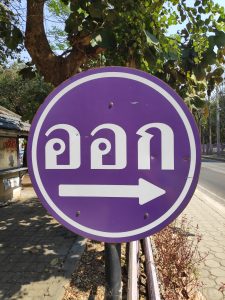Thai Script: First Look
The benefits of learning to read the Thai script from the start are enormous. This is in part due to the fact that it is very difficult to transliterate (or romanize) the Thai alphabet. Thai has 28 (actually more, but just 28 that we need to worry about) different written vowel “shapes” each which represent a single vowel sound. This is very different than in English where 5 letters (a, e, i, o, u) are used to represent a number of sounds across multiple dialects and accents. Consider the word, “cat.” If you asked native English speakers from around the world to pronounce this word, you would get a lot of different variations on what sound the “A” vowel represents. In Thai, each written vowel sound has only one possible pronunciation. That does mean a bit of extra work in the beginning to learn each vowel shape, but that also means that as you learn to recognize and say each vowel, you won’t have to worry about them again.
This course will gradually familiarize you with how the Thai script and sound system work using actual examples of very common words and phrases whenever possible. Nearly every word you encounter in the drills, flashcards and lessons are pulled from high frequency vocabulary that you will be able to use immediately.
There are approximately 50 lessons to be completed. Many of the lessons introduce one important point and a few new consonants or vowels along with some drills to practice them so on most days you should be aiming to complete 2-4 lessons as well as do a quick review of recent lessons if you need it.
It will probably take a couple weeks to familiarize yourself with the sounds and tone rules and quite a bit longer to truly master them. Within a couple of days of beginning this course, you should already be able to start picking out letters on signs and reading short words.
Let’s try looking at a very important Thai word that you will hear many times a day no matter what part of the country you find yourself in:
Thai:
กิน
Meaning: to eat
Breakdown: We can break this word into 3 parts which together form one syllable. This syllable consists of an Initial Consonant, a Vowel and a Final Consonant
- ก
- อิ *The vowel is the semi-circle shape above the basin letter (อ). Vowels are never written alone and must always be attached to a consonant.
- น
Notice how we attach an “aww” vowel sound after each of the consonant sounds. This happens for every consonant.
There are three pieces to this puzzle. An initial consonant, a vowel and a final consonant. The vowel is actually the shape above the letter in # 2 above. In Thai, you will never write a vowel shape by itself. It will always be attached to a letter. In the case of the above example, the vowel happens to appear on top of the letter it’s being attached to. This will not always be the case and the position of the vowel does not affect its pronunciation.
The chicken letter, ก is like a [k] sound, but be careful as it isn’t aspirated like most “k” sounds are in English. Aspirated consonants have a strong blast of air that comes out of your mouth when you pronounce them. Put your hand in front of your mouth and say the following words:
- car
- can
- cool
- back
- deck
You should have a felt a strong puff of air from the first 3 words and the same from the ending consonant of the final letter. In Thai, the chicken letter ก does not have that strong blast of air. Try saying a “k” very softly and see if you can stop yourself from sending out the puff of air. Remember to keep your hand in front of your mouth so you can feel the difference. If you feel a strong blast, you aren’t pronouncing it correctly and Thai people will have trouble understanding you. It may sound like a “g,” but it is not quite the same and better not to think of it this way. These items are just as important as getting the tones right so don’t neglect practicing it.
The อ letter you will see in all the following examples is a special placeholder that has no consonant sound value attached to it. Thai vowel shapes act like clothing for consonants. The consonants wear different vowels which give us different sound combinations.
Think about how we say the alphabet in English:
- B [bee]
- C [see]
- D [dee]
- E [eee]
When I say vowels are like clothing, imagine that the 4 letters above as all “wearing” an “eee” vowel. If you can wrap your head around that, you are on the right track.
Of course, not all English letters take that [eee] vowel sound as that would severely limit the amount of words you could produce with it, but hopefully you get the general idea. Now in Thai, we always add an [aww] vowel sound ออ to a consonant when we are referring to it. This is generally called an “inherent vowel,” meaning that if there is no other vowel written, we will use the ออ sound.
Thai words and syllables usually consist of two or three parts although some will have more. It’s different from English and may seem strange at times, but after you are a couple of hours into this course, I expect that everything should start becoming clearer for you. At this point, you will see how useful learning the script really is.
Hungry for more? Move on to the next lesson and get to work!
